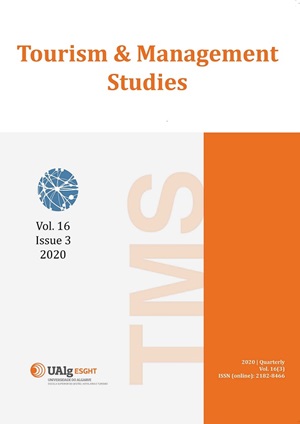Hybrid preference assessment for tourism research using solicited and unsolicited opinions: an application in rural tourism
DOI:
https://doi.org/10.18089/tms.2020.160301Keywords:
Social media analysis, online communities, tourists’ preferences, rural tourism, multiple criteria decision analysisAbstract
Social media analysis is a powerful tool for tourism research that, at a relatively low cost, can be used to manage and process large datasets of comments, ratings, and shares from different online communities. However, the heterogeneous nature of unsolicited opinions, the complexity of natural language assessment, and differences in the characteristics of social-data sources hinder the accurate assessment of preferences. However, the use of solicited data sources, such as direct polling, is typically resource-intensive, time-consuming, and geographically limited. We analyze a hybrid approach that combines active polling with passive social media analysis to rate tourist experience. To this end, we present a novel multiple criteria decision analysis model for preference-extraction from solicited and unsolicited data. The proposed approach can significantly reduce the number of polls required to accurately assess the preferences of a community.References
Andriotis, K., Agiomirgianakis, G., & Mihiotis, A. (2008). Measuring tourist satisfaction: A factor-cluster segmentation approach. Journal of Vacation Marketing, 14(3), 221–235. https://doi.org/10.1177/1356766708090584
Ayeh, J. K., Au, N., & Law, R. (2013). “Do We Believe in TripAdvisor?” Examining Credibility Perceptions and Online Travelers’ Attitude toward Using User-Generated Content. Journal of Travel Research, 52(4), 437–452. https://doi.org/10.1177/0047287512475217
Batrinca, B., & Treleaven, P. C. (2014). Social media analytics: a survey of techniques, tools and platforms. AI and Society, 30(1), 89–116. https://doi.org/10.1007/s00146-014-0549-4
Boley, B. B., Jordan, E. J., Kline, C., & Knollenberg, W. (2018). Social return and intent to travel. Tourism Management, 64, 119–128. https://doi.org/10.1016/j.tourman.2017.08.008
Brown, C. B. (2015). Tourism, crime and risk perception: An examination of broadcast media’s framing of negative Aruban sentiment in the Natalee Holloway case and its impact on tourism demand. Tourism Management Perspectives, 16, 266–277. https://doi.org/10.1016/J.TMP.2014.12.001
Fan, W., & Gordon, M. D. (2013). Unveiling the Power of Social Media Analytics. Communications of the ACM, 12(JUNE 2014), 1–26. https://doi.org/10.1145/2602574
Fernández, M. A., Bendodo, E., Sánchez, J. R., & Cabrera, F. E. (2017). A group decision process based on expert analysis and criteria coalition to measure municipalities’ financial distress. Soft Computing, 1–19. https://doi.org/10.1007/s00500-017-2991-y
Kelliher, F., Reinl, L., Johnson, T. G., & Joppe, M. (2018). The role of trust in building rural tourism micro firm network engagement: A multi-case study. Tourism Management, 68, 1–12. https://doi.org/10.1016/J.TOURMAN.2018.02.014
La Red, D. L., Doña, J. M., Peláez, J. I., & Fernández, E. B. (2011). WKC-OWA, a new Neat-OWA Operator to Aggregate Information in Democratic Decision Problems. International Journal of Uncertainty, Fuzziness and Knowledge-Based Systems, 19(05), 759–779. https://doi.org/10.1142/S0218488511007222
Liu, L., & Liang, H. (2016). Influence analysis for celebrities via public cloud and social platform. China Communications, 13(8), 53–62. https://doi.org/10.1109/CC.2016.7563688
Liutikas, D. (2017). The manifestation of values and identity in traveling: The social engagement of pilgrimage. Tourism Management Perspectives, 24, 217–224. https://doi.org/10.1016/J.TMP.2017.07.014
Monterrubio, C. (2017). Protests and tourism crises: A social movement approach to causality. Tourism Management Perspectives, 22, 82–89. https://doi.org/10.1016/J.TMP.2017.03.001
Munar, A. M., & Jacobsen, J. K. S. (2014). Motivations for sharing tourism experiences through social media. Tourism Management, 43, 46–54. https://doi.org/10.1016/j.tourman.2014.01.012
Ordenes, F. V., Ludwig, S., De Ruyter, K., Grewal, D., & Wetzels, M. (2017). Unveiling What Is Written in the Stars: Analyzing Explicit, Implicit and Discourse Patterns of Sentiment in Social Media. Journal of Consumer Research, 43(6), ucw070. https://doi.org/10.1093/jcr/ucw070
Otte, E., & Rousseau, R. (2002). Social network analysis: a powerful strategy, also for the information sciences. Journal of Information Science, 28(6), 441–453. https://doi.org/10.1177/016555150202800601
Peláez, J. I., Cabrera, F. E., & Vargas, L. G. (2018). Estimating the relevance of consumer purchasing criteria in digital ecosystems. Knowledge-Based Systems. https://doi.org/10.1016/J.KNOSYS.2018.07.023
Rai, A., Minsker, B., Diesner, J., Karahalios, K., & Sun, Y. (2018). Identification of Landscape Preferences by Using Social Media Analysis. In 2018 International Workshop on Social Sensing (SocialSens) (pp. 44–49). IEEE. https://doi.org/10.1109/SocialSens.2018.00021
Sandberg, L., Jaradat, S., & Dokoohaki, N. (2016). The social media election agenda: Issue salience on Twitter during the European and Swedish 2014 elections. In 2016 IEEE/ACM International Conference on Advances in Social Networks Analysis and Mining (ASONAM) (pp. 793–794). IEEE. https://doi.org/10.1109/ASONAM.2016.7752328
Schroeder, A., Pennington-Gray, L., Kim, H., & Liu-Lastres, B. (2018). Using the media’s tweets to broaden previous conceptualizations of political travel risks. Tourism Management Perspectives, 26, 107–117. https://doi.org/10.1016/J.TMP.2018.03.001
Turismo y Planificación Costa del Sol S.L.U. (2017). Observatorio Turístico de la Costa del Sol 2017. Málaga.
Vagias, W. M. (2006). Likert-type scale response anchors. Clemson International Institute for Tourism & Research Development, Department of Parks, Recreation and Tourism Management. Clemson University.
Vargas, L. G. (2016). Voting with intensity of preferences. International Journal of Information Technology & Decision Making, 15(4), 839–859. https://doi.org/10.1142/S0219622016400058
Xiang, Z., Du, Q., Ma, Y., & Fan, W. (2017). A comparative analysis of major online review platforms: Implications for social media analytics in hospitality and tourism. Tourism Management, 58, 51–65. https://doi.org/10.1016/j.tourman.2016.10.001
Zatori, A., Smith, M. K., & Puczko, L. (2018). Experience-involvement, memorability and authenticity: The service provider’s effect on tourist experience. Tourism Management, 67, 111–126. https://doi.org/10.1016/J.TOURMAN.2017.12.013
Zeng, B., & Gerritsen, R. (2014). What do we know about social media in tourism? A review. Tourism Management Perspectives, 10, 27–36. https://doi.org/10.1016/J.TMP.2014.01.001
Downloads
Published
Issue
Section
License
Copyright (c) 2020 Tourism & Management Studies

This work is licensed under a Creative Commons Attribution-NoDerivatives 4.0 International License.
The journal retains published articles’ copyrights, but they are simultaneously licensed under the Creative Commons Attribution License (CC BY-NC-ND), which allows individuals’ to share the relevant papers as long as authorship and publication in this journal are duly acknowledged.



